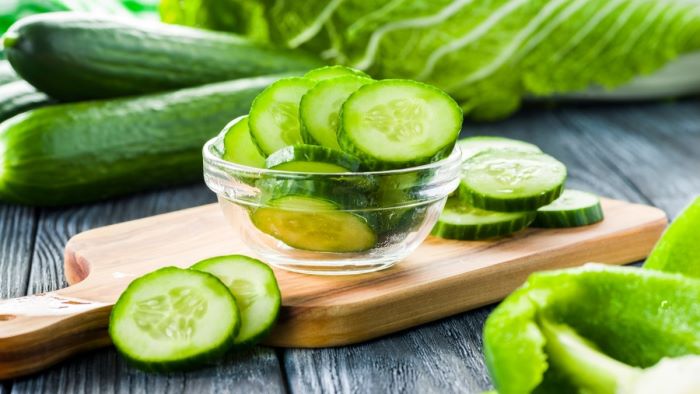If you love cucumbers, you might want to grow your own at-home garden. But how do you start from a tiny seed and end up with a crunchy, juicy, and refreshing cucumber? What are the different stages of cucumber plant development?
To answer all your questions, we have prepared a blog for you, which will answer these questions and more. We will give you an overview of the different stages of cucumber plant growth, from seed to fruit.
By the end of this post, you will be ready to grow your own cucumbers and enjoy them in salads, pickles, or just as a snack! 🥒😋
Contents
The 5 Cucumber Plant Growth Stages
Cucumber plants have a life cycle that consists of five main stages: seed germination, vine growth, flowering and pollination, fruit production, and harvesting. The duration of each stage depends on the variety of cucumbers, the weather, the soil, and the care you give to your plants. It has been observed that cucumbers take between 50 and 70 days to mature from seed to fruit.
Let’s take a look at different cucumber plant stages in detail.
1. Seed Germination
The first stage of cucumber plant growth is seed germination. This is when the seed sprouts and develops its first leaves. To germinate cucumber seeds, you need to sow them in moist and fertile soil, preferably in a sunny location.

Furthermore, the optimal soil temperature for germination is between 70 and 95 degrees Fahrenheit. Plus, you can also start your seeds indoors in pots or trays, and transplant them outside when they have at least two sets of true leaves.
Once your seedlings have at least two sets of true leaves and are about four inches tall, you can thin them out.🌱
2. Vine Growth
Now, the next stage of cucumber plant growth is vine growth. This is when the plant develops its stem, branches, and tendrils. Cucumber plants are vines that can grow up to 15 feet long, depending on the variety. They need plenty of space to spread out horizontally or vertically. So, you can either let them grow on the ground, or train them to climb a trellis, a fence, or a stake. This will help prevent diseases, pests, and rotting of the fruits.
Furthermore, cucumber vines grow rapidly and require regular watering and fertilizing to support their growth. You should water your plants deeply and frequently, especially during hot and dry weather. It is also recommended to apply a balanced fertilizer every two weeks.
Avoid overwatering or overfertilizing your plants, as this can cause problems. Such as blossom end rot or bitter fruits.
3. Flowering and Pollination
The third stage of cucumber plant growth is flowering and pollination. During this period, the plant produces its male and female flowers, which are necessary for fruit formation. Cucumber flowers are bright yellow and have five petals, and they usually appear about 40 days after planting.
Furthermore, there are two types of cucumber plants: monoecious and gynoecious. Monoecious plants have both male and female flowers on the same plant, while gynoecious plants have only female flowers.

For monoecious plants, you need bees or other pollinators to transfer pollen from the male flowers to the female flowers. You can also hand-pollinate your plants by using a small brush or cotton swab to gently rub the pollen from the male flowers.
On the other hand, for gynoecious plants, you don’t need pollination at all, as they produce fruit without fertilization, and this is called parthenocarpy.
However, you may need to plant some monoecious plants nearby to ensure fruit set and prevent seed formation.
4. Cucumber Fruit Production
Another stage of cucumber plant growth is fruit production. This is when the plant develops its fruits from the fertilized or unfertilized female flowers. Cucumber fruits are technically berries that have a green skin and a white flesh with many seeds inside.

In addition, cucumber fruits grow quickly and can be ready for harvest in as little as 10 days after flowering. The size and shape of the fruits depend on the variety of cucumber and the growing conditions.
Some varieties produce small and slender fruits that are ideal for pickling or slicing, while others produce large and fat fruits that are good for stuffing or juicing.
5. Cucumber Plant Harvesting Time
The fifth and final stage of cucumber plant growth is harvesting time. You can enjoy the fruits of your labor and eat your fresh and crunchy cucumbers. Plus, you can store your cucumbers in the refrigerator for up to a week, or preserve them by pickling or fermenting them.
Additionally, you can also save some seeds from your cucumbers for next year’s planting. To do this, you need to select some ripe and healthy fruits from your plants, and cut them open and scoop out the seeds.
Store cucumber seeds in a cool and dry place until you are ready to sow them again.
Also read: Zucchini Growing Tips: How to Grow Zucchini Plants?
FAQs
How to control cucumber plant growth?
There are several ways to control cucumber plant growth and prevent them from getting too tall or spreading too much. One of the methods are: Pruning the plants regularly by removing dead, damaged, or diseased parts, as well as suckers that grow from the main vine.
What is the life cycle of a cucumber?
The life cycle of a cucumber is the process of growth and development that a cucumber plant goes through from seed to fruit. It consists of five main stages: seed germination, vine growth, flowering and pollination, fruit production, and harvesting. Each stage has its own characteristics and requirements, and the duration of each stage varies depending on the variety of cucumber and the environmental conditions.
What do cucumbers look like when they’re starting to grow?
Cucumbers look like small green bumps when they are starting to grow. They are attached to the base of the female flowers, which are larger than the male flowers and have a tiny cucumber-shaped ovary. The female flowers need to be pollinated by bees or other insects, or by hand, in order to produce cucumbers.
Conclusion
We hope you enjoyed reading the blog about the different stages of cucumber plant growth.
As now, you know, growing cucumbers is a fun activity that can provide you with fresh and tasty vegetables for your salads, sandwiches, and snacks. By following the steps you can ensure that your cucumber plants are healthy, productive, and delicious.
Remember to plant your cucumbers at the right time, water them regularly, fertilize them when needed. You can also prevent or treat common pests and diseases that might affect your cucumbers. Such as aphids, powdery mildew, and cucumber mosaic virus.
With a little care and attention, you can enjoy your cucumbers all summer long! 😊

Hi, I’m Jacqueline, the editor-in-chief of cozynest. I have a passion for plants and gardening, also, have a degree in horticulture from the University of California, Davis. I love to share my knowledge and experience with our readers and help them create beautiful and healthy gardens, indoors, and outdoors. I also enjoy experimenting with different plant varieties, designs, and techniques, and learning from other experts in the field. When I’m not working on cozynest, you can find me in my own cozy nest, surrounded by my favorite plants and books.

